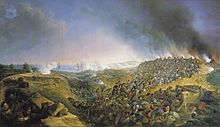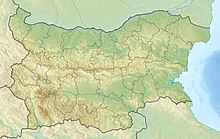Siege of Varna
| Siege of Varna | |||||||
|---|---|---|---|---|---|---|---|
| Part of the Russo–Turkish War, 1828–1829 | |||||||
 Painting by Alexander Sauerweid (1836) | |||||||
| |||||||
| Belligerents | |||||||
|
| |||||||
| Commanders and leaders | |||||||
|
|
| ||||||
| Strength | |||||||
|
40,519 men, 118 cannons[1] 8 ships of the line, 5 frigates, 13 small vessels, 52 naval cannons[1] | |||||||
| Casualties and losses | |||||||
| Unknown |
Unknown number of dead/wounded/missing 10,887 captured[1] | ||||||
Location within Bulgaria | |||||||
The siege of Varna (July 13 – September 29, 1828) took place during the Russo-Turkish War, 1828–1829.
History
Varna was held by the Ottoman army. An approach to Varna by Russian forces was first attempted on June 28, but the Russian advance guard under Adjutant General Count Pavel Petrovich Suchtelen was met by significant Turkish forces, and the siege was postponed. On 6 July the detachment of General Pavel Nikolayevich Ushakov arrived, which was to replace Suchtelen's detachment. Ushakov strengthened the position of encirclement and repelled a sortie and attack near the village of Gebeji on 8 July. Fearing exhaustion of the forces from sorties, Ushakov took his detachment back to Dervent-Kioy, covering communications with Shumla and watching the road to Kavarna, where he remained until 19 July, when the detachment was reinforced by 2 brigades that arrived from Anapa.[1]
By the end of July, the Black Sea Fleet under the command of Admiral Aleksey Samuilovich Greig approached Varna and delivered the landing forces. In mid-August the Guards Corps arrived at Varna, with Emperor Nicholas I. The siege was put under the command of Adjutant General Prince Alexander Sergeyevich Menshikov, with total forces of 23,000 personnel and 170 artillery pieces against the 12,000 garrison of Varna under Vizier Yusuf Pasha. When Menshikov was wounded with a cannonball to both feet, the siege was entrusted to General Field Marshal Count Mikhail Semyonovich Vorontsov (he arrived on 17 August), but before that, command was temporarily transferred to Major General Vasily Alekseevich Perovsky. On 21 August the Turks were driven out of counter-laufgraben [de] by a bayonet strike.[1]
In the meantime, Greig's fleet actively assisted the siege by bombardment, landing, blockade of the territory from the sea and supplying it with large artillery.[1] Among the participants of naval siege was the future discoverer of Antarctica, Fabian von Bellingshausen (Faddey Bellingshausen).
In an attempt to relieve the siege of Varna, Omer Vrioni brought an army of 20,000 but was successfully held off. At the battle of Kurtepe the Russians under Prince Eugen of Württemberg attacked but they were defeated and retreated, despite the defensive success of General Karl Ivanovich Bistram's troops, who had repulsed both the garrison and Omer Vrioni's army. However, the Turks did not follow up this victory and waited 11 days at the place.[2] On 1 September the central redoubt was stormed and a counter-laufgraben were cleared with bayonets. Siege works were now carried out by order of General Trousson 2nd; on 31 August the attackers had set up trench on the crest of glacis, and on 2 September the saps with 300 pounds of powder were blown up and a convenient descent into the ditch was formed. The proposal to surrender the fortress was rejected, and by order of Nicholas proceeded to the close attack and preparation of the assault on the bastions. On 4 September the siege artillery arrived, due to which the Turkish artillery fire was suppressed, and the attack moved forward quickly. Colonel Schilder had to use a special method to cross the ditch of the second bastion. From the mine gallery in the counterscarp he made an opening into the moat, thrown away the Turks from the moat by rifle fire, and went forward along a sap made of plank shields, with overhead fascines covering them. The moat was thrown with water fascines and a roofed sap made of cairns and covered with fascines. In this way they reached the scarp and, in spite of the desperate garrison's sorties and the destruction of that works, laid mines.[1] Eventually, Varna capitulated.[2]
Varna was taken with 6,900 prisoners and 140 artillery pieces. The town was surrendered by Yusuf Pasha.[2]
However, the Russians suffered big losses during the summer-autumn campaign and withdrew from Varna and the Danube to resume the campaign in the following spring. The Russians had lost 6,000 men in the siege from battles and disease.[2]
References
- Kersnovsky, Anton, History of the Russian Army, Belgrade, 1933–1936, reprinted by Golos, 1992–1994 [1].
- Velichko, Konstantin I.; Novitsky, Vasily F.; Schwarz, Alexey V. von; Apushkin, Vladimir A.; Schoultz, Gustav K. von (1911). Военная энциклопедия [Military Encyclopedia] (in Russian). Vol. V: Бомбарда – Верещагин. Moscow: Типография Т-ва И. Д. Сытина. pp. 239–241. Retrieved 4 November 2023.
- Articles with short description
- Short description is different from Wikidata
- Use dmy dates from November 2021
- Coordinates on Wikidata
- CS1: long volume value
- CS1 Russian-language sources (ru)
- Battles of the Russo-Turkish War (1828–29)
- Sieges involving the Ottoman Empire
- Conflicts in 1828
- History of Varna, Bulgaria

